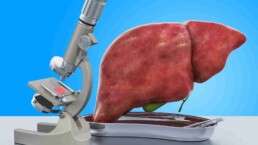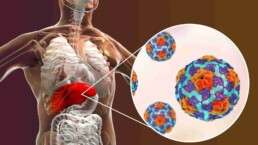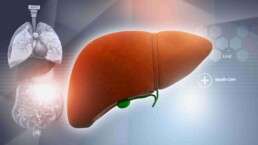Dr. Good Deed’s Health Clinic in Patna! Our team of skilled generalphysicians, Neurologist and gastroentrologist experts provides comprehensive healthcare solutions. Enjoy minimal wait times at our convenient Kankarbagh and Boring Road clinics. Experience the convenience of online consultations for quality healthcare from home.
What is LIVER Disease?
The liver is the second-largest organ in your body, behind the skin. It is around the size of a football and sits on your right side, just under your ribcage. As nutrients and trash pass through your digestive system, the liver separates them. Additionally, it creates bile, a fluid that facilitates digestion and transports toxins from your body.
Any of the various illnesses that can harm your liver are referred to as “liver diseases. Liver illness can eventually lead to cirrhosis (scarring). The liver can no longer function normally when more scar tissue replaces good liver tissue. Liver failure and liver cancer can result from untreated liver illnesses.


Causes of Liver Disease
Hepatitis is a liver inflammation brought on by a virus, an inherited condition, or occasionally by a toxin or specific treatments, such as alcohol or drugs. Hepatitis A, B, C, and D are the four most common forms of viral hepatitis.
Waterborne hepatitis A is primarily transmitted by sewage, tainted food, and polluted water.
Hepatitis B can be passed from mother to child by contact with infected blood, vaginal fluids, or semen.
Unprotected sex and sharing infected needles (such as those used for acupuncture, tattooing, and ear piercing) are the two main ways hepatitis B is transmitted.
Direct blood-to-blood contact is the primary way that hepatitis C spreads.
Infected needles and blood transfusions spread hepatitis D.
Symptoms of Liver disease
There are not many symptoms of cirrhosis or hepatitis. Most varieties of hepatitis have an acute phase that includes flu-like symptoms such as fatigue, fever, nausea, vomiting, appetite loss, and pain, typically under the ribcage on the right side of the belly. Jaundice, or yellowing of the skin and eye whites, could also exist.
Other indicators of liver disease could be:
- Gut (abdominal) pain, particularly on the right side.
- Prone to bruising.
- Alterations in the color of your stool or urine.
- Fatigue.
- Vomiting or feeling nauseous.
- Edema, or swelling, in the arms or legs.
Doctors use blood tests and an exhaustive personal history to identify hepatitis. They’ll inquire if you have the following:
Medications intravenously.
Fresh shellfish from contaminated waters
nations where hepatitis diseases are prevalent.
Had dangerous sexual habits, received a blood transfusion, or had contact with new blood
and taken specific drugs within the past few months.
Prevention
Drink a few drinks. Includes up to one alcoholic beverage per day for women and two drinks per day for men for healthy individuals. More than eight drinks a week for women and more than 15 drinks a week for men are considered complex or high-risk.
Prevent dangerous behavior. Use a condom during sex. If you get a tattoo or piercing, choose a shop for hygiene and safety. If you are using illegal intravenous drugs, seek treatment. Don’t forgive needles if you’re injecting medicine.
Get the vaccine. Discuss getting the hepatitis A and B vaccines with your doctor if you are likely to get hepatitis or already have any viruses.
Take medication as prescribed. Prescribe and take medication only as directed and when needed. Do not mix alcohol and drugs. Consult a doctor before combining herbal supplements or prescription drugs.
Keep them away from other body fluids and blood. Accidental stabbing and improper handling of blood or body fluids can transmit the hepatitis virus.
Maintain a safe diet. Wash your hands thoroughly before eating or preparing food. If traveling to a developing country, use bottled water, wash your hands frequently, and brush your teeth.
Be careful when using aerosol sprays. Wear a mask and use these products in a well-ventilated area when applying paint, pesticides, fungicides, or other hazardous materials. Always follow the manufacturer’s instructions.
Keep your skin safe. Wear gloves with your sleeves extended, a hat, and a mask when using insecticides and other hazardous chemicals to prevent chemical absorption through your skin.
Risk of liver disease
Which variables put this condition at risk?
You might be more susceptible to developing liver cirrhosis if you:
- heavy drinking
- Obesity
- diabetes type 2
- Body art or piercings
- drug injection using shared needles
- exposure to bodily fluids and the blood of others
- Unrestricted sex
- exposure to certain poisons or substances
- an inheritance of liver illness


Diagnosis Liver Disease
Blood test. A panel of liver function tests might reveal signs of liver illness and liver failure. These gauge the quantities of bilirubin, proteins, and other liver products in your blood. Additionally, certain disorders or recognized adverse effects, such as impaired blood coagulation, may be detected by blood tests.
Image-based tests. Your liver’s size, shape, and texture can be seen by imaging procedures like an abdominal ultrasound, CT scan, or MRI. Elastography, a specialized imaging procedure, uses MRI or ultrasound technologies to assess the degree of liver fibrosis or stiffness.
Liver biopsy. A liver biopsy is a quick operation to remove a small piece of liver tissue for laboratory testing. Typically, a medical professional can use a hollow needle to collect the sample. A liver biopsy can c
What is a liver abscess?
If you experience any symptoms, you should get in touch with the best radiologists in Udaipur right away. A cerebral blood clot is treated by:
A severe infection is a liver abscess. It may result in fatalities and other significant issues. The tissue close to where it is detected may suffer damage. Additionally, it may result in symptoms like fever, discomfort, nausea, diarrhea, and appetite loss. Sepsis, a severe infection that affects the entire body, can result from it.
Liver abscess symptoms can include:
- Right upper abdominal pain occurs more often than general abdominal pain.
- Toned like clay stools.
- Urine color.
- Night sweats, chills, and fever
- Decrease in appetite.
- Nausea and vomiting.
- Weakness.
Treatment of a liver abscess
The etiology of the abscess will determine the type of treatment you receive. It also depends on how many and how significant your blemishes are. Treatment options include:
Medication. The first line of defense against an abscess is an antibiotic or antifungal. For a few weeks, you will need to take medication. It can be consumed orally as a tablet or drink. Alternatively, the remedy might be injected into a vein using an IV (intravenous) tube.
Removing the abscess fluid. In addition to taking medication, this is an option. Or maybe performed if the drug does not work or the infection causes other side effects. Liver tumors can be removed in several ways. The doctor may insert a syringe needle under your skin and into the wart. The person then draws the fluid with a syringe. We call this willpower. The supplier could also insert a small wire into your skin. The doctor may use an ultrasound or CT scan to help position the wire. A thin, flexible needle (catheter) is inserted over the wire to create a clot. The tube was left in place for 5 to 7 days to drain.


Liver transplant cost in Delhi
The cost of a liver transplant in Delhi is a significant concern for patients and their families. The procedure involves a complex and intricate surgical process, requiring specialized medical expertise and state-of-the-art facilities. The expenses associated with a liver transplant include pre-operative tests, hospitalization, surgical fees, post-operative care, and medication. The cost may vary depending on the hospital, the surgeon’s experience, and the patient’s medical condition. It is advisable to consult with a qualified healthcare professional to obtain a detailed estimate of the expenses involved in the liver transplant procedure. Patients should also explore various financing options and insurance coverage to manage the financial burden of the treatment.
